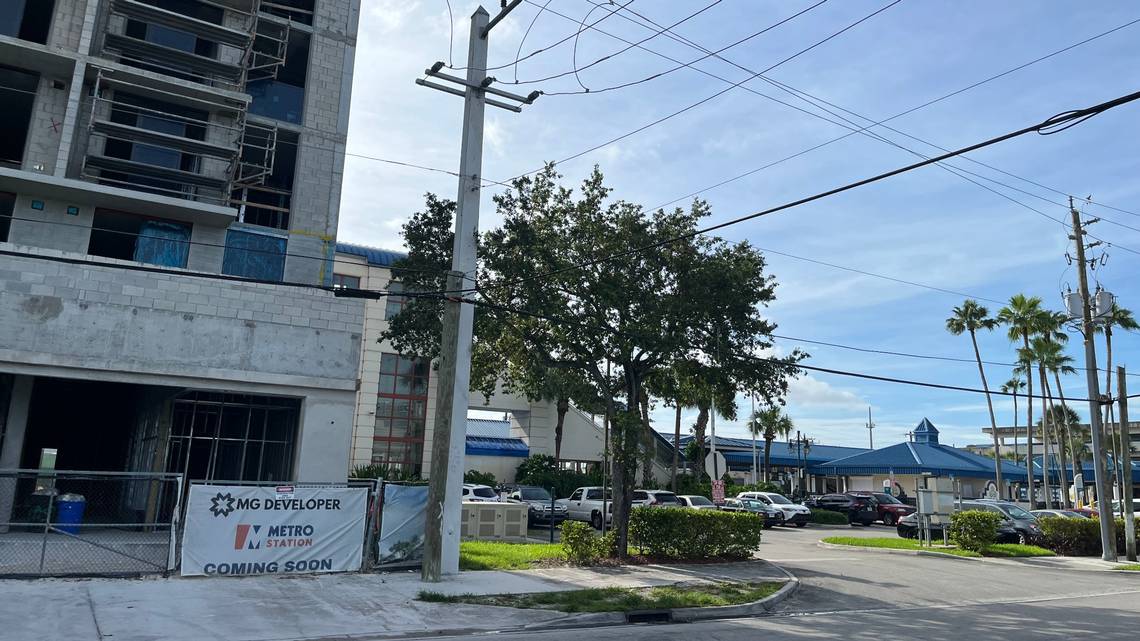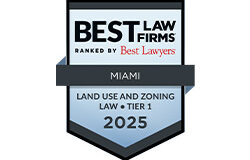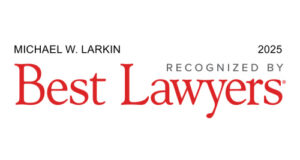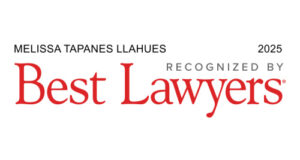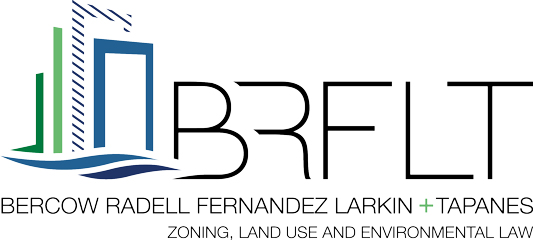CLIENT NEWS: How a housing village rising at a Hialeah train station is changing a community
July 1, 2025As commuters unload from carpools passing through the parking lot of a Tri-Rail station on a recent weekday morning, they’re greeted by a symphony of construction while waiting for their trains.
Buzz saws and percussion drills crank up just 10 feet from the train platform, where workers in green vests and yellow safety helmets are building a new housing development.
The eight-story residential building, named Metro Station 1, broke ground in May with a target completion by January 2026. The building will offer 55 apartments in a convenient place: next to Tri-Rail’s Metrorail Transfer Station in Hialeah. The structure’s balconies are under construction directly above the tracks, and the building will even share a parking lot with the station.
Mere seconds, not minutes, from the train platform, Metro Station 1 is the closest new housing going up, but it’s far from the only residential project near the transit hub, which connects to Metrorail and a rail route to the downtown Miami Brightline station. Within three blocks of the station, three new rental apartment buildings broke ground in May and June — and more are being planned.
They are the latest additions to what developers have dubbed Hialeah’s “Metro District,” a high-density residential area of buildings within blocks of Tri-Rail and Metrorail. Seven buildings are either planned, under construction or newly opened in the neighborhood, each between 8 and 10 stories, totaling over 3,000 units of new housing.
The intersection of the Metrorail and Tri-Rail lines has become the center of an ambitious plan to transform the area. Renters started moving into the first building earlier this year, following completion of Metro Parc on East 26th Street.
“The apartment is super nice and incredibly convenient,” said John Martin, 64, one of the first people to move into Metro Parc. “Just look at the location — you walk across the street to the station and you can be in Orlando in an hour and a half or West Palm Beach in 30 minutes. You can get to Brickell in 25 minutes — a couple moving in definitely wouldn’t need two cars.”
According to the developers, rent at Metro Parc ranges from around $1,800 to $3,000 a month; the average rent in Hialeah is around $2,100, according to estimates made by national real estate broker Redfin.
Developers say they are aiming to rent about 75 percent of the apartments at below market rates, making use of Florida’s Live Local Act, which rewards companies with tax incentives if they set aside units for workforce housing, requiring prices to be at least 10 percent below an area’s average rental cost.
“It’s the genesis of the transit district in Hialeah,” said Ivo Fernandez Jr., co-founder of Modis Architects, the Miami firm involved in the design of Metro Parc and the six other buildings that will form the Metro District.
Fernandez said the new housing projects will create the kind of “vibrant and pedestrian community that’s hard to find outside of downtown Miami.”
Modis Architects hopes that high-density residential development around the transit hub will persuade younger people to stay in Hialeah instead of moving away to pursue careers.
“Hialeah is what I consider the backbone of Miami-Dade County; it’s a workforce community,” Fernandez said, noting that the area’s multi-generational family housing has sustained working-class families but often led their ambitious children to eventually move away.
“In the past, what you got in Hialeah was just apartments and parking lots,” Fernandez said. “What Metro Park offers is beyond that. It’s higher-level living with nice lobbies, lounge areas, multi-purpose rooms, fitness centers, pool decks, outdoor amenities.”
MG Developer, the Florida real estate development firm behind Metro Parc and Metro Station, hopes the new buildings and their amenities will appeal not just to young professionals in the area, but also downtown Miami residents seeking to escape rising rents.
What’s riding in the train station neighborhood?
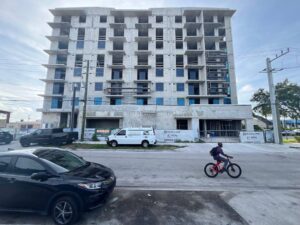 “Miami is not getting any cheaper,” said Diego Torrealba, executive vice president of MG Developer. “People are getting squeezed out of markets like downtown, Brickell, Coconut Grove and are looking for transit-oriented developments that can allow them to quickly get to where they work.”
“Miami is not getting any cheaper,” said Diego Torrealba, executive vice president of MG Developer. “People are getting squeezed out of markets like downtown, Brickell, Coconut Grove and are looking for transit-oriented developments that can allow them to quickly get to where they work.”
The changes underway and planned for Hialeah are rooted in a proposal led by Debora Storch, the director of planning and zoning for the city. Storch championed rezoning the area where Metrorail and Tri-Rail intersect, creating a transit district that allows developers to build high-density housing. Blocks that were filled with single family homes are rapidly being bought up and cleared to make way for the new apartment complexes.
Following the rezoning, Metro Parc was the first construction to go up in the district. Its a 10-floor building with a pool in the courtyard and 559 studios and one- and two-bedroom apartments.
Similar buildings are planned to fan out from all sides of Metro Parc. Across East 26th Street, the entire block between 9th and 10th avenues, once the site of over a dozen single family homes, was cleared earlier this year for “Metro Parc North,” a 661-apartment development. Construction began last month.
A Metro Parc West project of 420 apartments is in the preliminary design phase and a Metro Parc South project broke ground earlier in June, which will add 347 rental units. Finally, to the east, one block over along East 11th Avenue, the Metro Station 1 project next to the Tri-Rail station will also bring an adjacent and larger sister building. Metro Station 2 is in the permitting process, with construction on an additional 110 apartments planned to begin next year.
Homeowners are leaving the transit area
The neighborhood is experiencing a rapid period of change, with potentially thousands of new residents moving in over the next years. But many of the area’s longtime residents are in the process of moving out.
“They’ve got me surrounded on all sides; I’m boxed in,” said Vivencio Bello, an 84-year-old retired construction worker who has lived in the neighborhood for 42 years. “Everyone here bought houses to live in them, not to sell them. “But,” Bello said, chuckling, “you have to remember this is a capitalist country.”
 Bello said he and his neighbors were all offered above-market prices by developers eager to buy their single-family homes, clearing the way for yet another city block-sized housing development, The Edgar, a project planned to add 642 apartments just a block away from the Metro Parc and Metro Station buildings.
Bello said he and his neighbors were all offered above-market prices by developers eager to buy their single-family homes, clearing the way for yet another city block-sized housing development, The Edgar, a project planned to add 642 apartments just a block away from the Metro Parc and Metro Station buildings.
“Everyone’s moving out,” Bello, who plans to relocate to North Carolina, said of his neighbors. “But hey, they are paying good prices for our houses.”
Stuck in the middle of it all, surrounded in each direction by buildings either planned or already raised, diners at the Cuatro Esquinas Restaurant expressed some trepidation about the changes in the neighborhood.
“I don’t know where they’re going to find people to live in these buildings,” said Moreno Suarez, 62, a mechanic who regularly stops in for lunch between shifts at the auto shop across the street. “Who’s going to rent them? They’re too expensive.” he added.
Suarez and his co-workers said they expected economic uncertainty and anxiety over immigration issues would deter many of the neighborhood’s residents from signing yearlong leases and moving into the new apartments rising around them. The mechanics also worried that their auto shop, which services primarily commercial trucks, won’t profit from the incoming changes in the neighborhood.
“There’s no benefit for us or the businesses here from these big buildings,” Suarez said.
Matthew Baron, president of Baron Property Group, which partnered with MG Developer on Metro Parc, said around 10 percent of the building has been leased so far.
“We’re in the early innings of this stage of the area’s growth around the transit-oriented district,” Baron said. “We’re putting a lot of density in, retail is going to follow that density, and it’s going to become a self-fulfilling cycle where the area will become its own neighborhood.”
Baron said his aim is to repeat in Hialeah what his company accomplished in New York two decades ago, where he leveraged lower land costs in Long Island City to develop high-density housing. Ever-higher rents just across the river in Manhattan led residents to flock to Long Island City, where rent was more affordable and transit options made it easy for residents to commute for work.
“The things that attracted us to Long Island City 20 years ago, when I came to Hialeah, I was like, this is the same thing, all of those characteristics, it’s perfect,” Baron said. “It allows us to deliver a product that can be 25, 30, maybe even 35 percent less than what you would pay for rent in areas like Brickell and Wynwood.”
Average rent in Miami in May was around $2,962, according to estimates from Redfin. For both Brickell and Wynwood, the average cost was well over $3,700 a month for rentals.
Most of the new housing developments in Hialeah’s Metro District have street-level space for retail and services. Developers hope that dry cleaners, nail salons and grocery stores will move into buildings.
No outside businesses have set up yet on the bottom floor of Metro Parc, but, Baron said “we do have a lot of interest and we’re pretty close on a couple of deals.”
With the next decade, Baron said he expects the Metro District to look entirely different.
“I think that there’ll be more density, there’ll be more retail, and that area will just continue to grow.”
